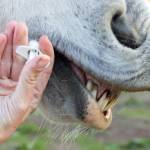Home Sweet Home: A Potential Source of Equine Parasites

Small strongyles—short, reddish parasites that live in the lumen of the large intestine—pose a big problem for horses and their owners in many ways. Poor hair coats, ill thrift, weight loss or failure to gain weight, colic, diarrhea, and resistance to chemical dewormers contribute to both frustration and economical losses throughout the equine industry.
To fully grasp the damaging effects of small strongyles, horse owners should understand the parasite’s basic life cycle. First, adult female parasites that are present in host horses lay eggs that are shed in manure. Those eggs hatch to form first-stage larvae, which molt into second- and then third-stage larvae. Only these third-stage larvae are infective to horses when ingested.
Once a horse consumes third-stage larvae, they migrate to and burrow into the wall of the large intestine and cecum. Third-stage larvae then “encyst” or hibernate for days to years. While encysted, the third-stage larvae develop into late third-stage larvae, fourth-stage larvae, and ultimately emerge from the wall of the large intestine or cecum, feed on the surface of those structures, and develop into adult parasites that start the vicious cycle again.
A key point of this life cycle is that horses are presumably infected with third-stage larvae on pasture. But are they? According to a recent study presented at the latest British Equine Association Congress, if a horse defecates in a stall bedded with straw, strongyle eggs passed in horse feces are capable of developing to infective third-stage larvae.
“These study findings imply that horse owners may be dropping the ball when instituting parasite control strategies,” noted Kathleen Crandell, Ph.D., an equine nutritionist for Kentucky Equine Research.
To help control parasite burdens, consider integrating some standard pasture management protocols into your stall management routine, such as removing fecal piles frequently and composting the bedding and manure. In addition, experts recommend adopting fecal egg count-based deworming strategies to help control internal parasites and extend the lifespan of chemical dewormers.
*McGirr, E.C., M.J. Denwood, J. McGoldrick, et al. 2015. Equine cyathostominae can develop to infective third larvae on straw bedding. In: Proc. British Equine Veterinary Association Congress. Equine Veterinary Journal. 47(Suppl. 48):9.








